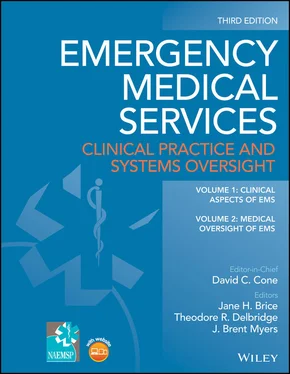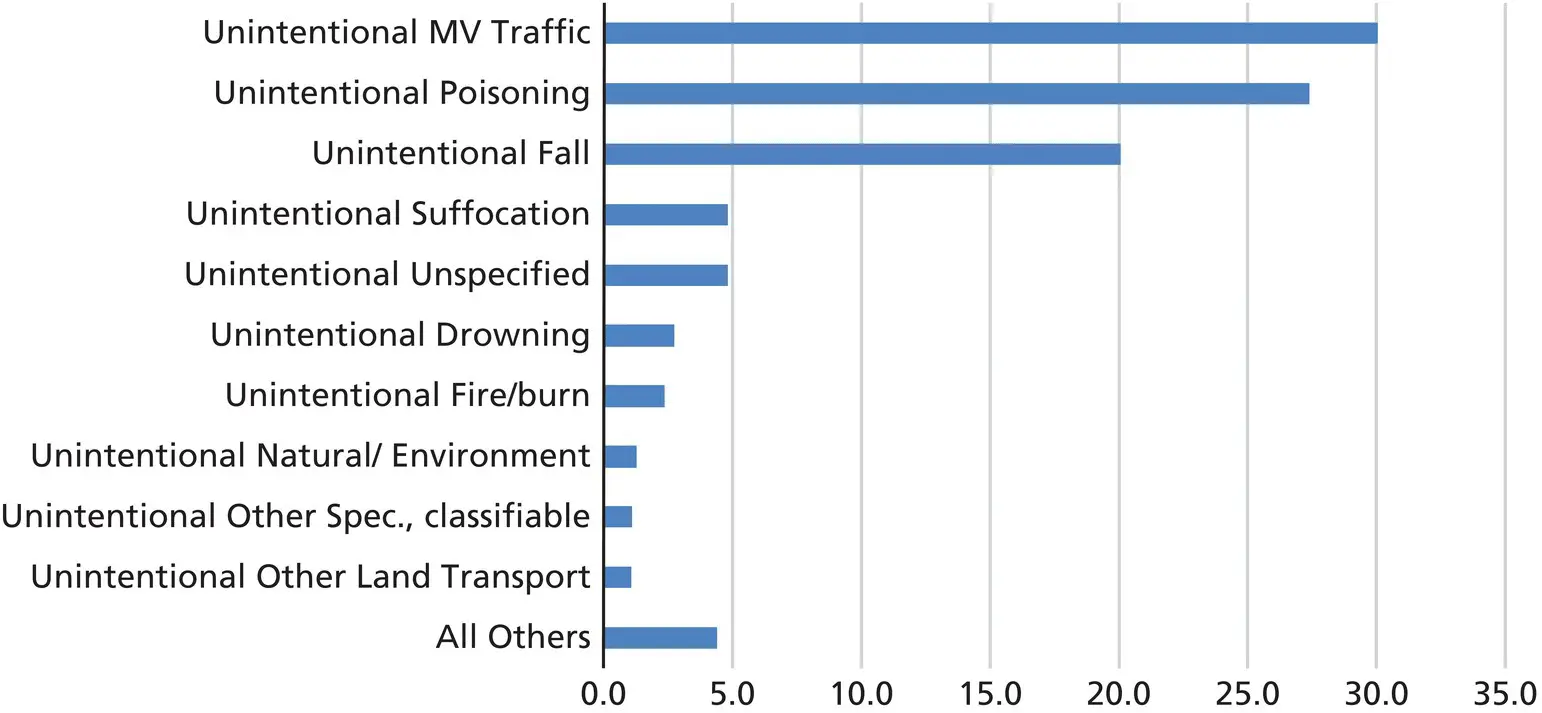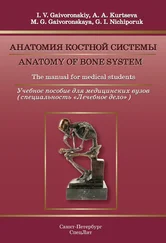56 56 Centers for Disease Control and Prevention. Ebola (Ebola virus disease). Emergency services. Last reviewed: January 28, 2016. Available at: https://www.cdc.gov/vhf/ebola/clinicians/emergency‐services/index.html. Accessed February 14, 2021.
57 57 Kratochvil CJ, Evans L, Ribner BS, et al. The National Ebola Training and Education Center: preparing the United States for Ebola and other special pathogens. Health Secur. 2017; 15(3):253–60.
58 58 Kuhar DT, Carrico R, Cox K. Infection Control in Healthcare Personnel: Infrastructure and Routine Practices for Occupational Infection Prevention and Control Services. Washington, DC: Centers for Disease Control and Prevention, 2019.
59 59 Centers for Disease Control and Prevention. Immunization of health‐care personnel: recommendations of the Advisory Committee on Immunization Practices (ACIP). MMWR Recomm Rep. 2011; 60(RR‐7):1–45.
60 60 Gardner P. Clinical practice: prevention of meningococcal disease. N Engl J Med. 2006; 355:1466–73.
61 61 Centers for Disease Control and Prevention. Prevention and control of meningococcal disease: recommendations of the Advisory Committee on Immunization Practices (ACIP). MMWR Recomm Rep. 2005; 54(RR‐07):1–21.
62 62 Liu Y, Gayle AA, Wilder‐Smith A, Rocklöv J. The reproductive number of COVID‐19 is higher compared to SARS coronavirus. J Travel Med. 2020; 27(2):taaa021.
63 63 World Health Organization. WHO Coronavirus Disease (COVID‐19) Dashboard. Available at: https://covid19.who.int. Accessed April 5, 2021.
64 64 Centers for Disease Control and Prevention. 1918 pandemic (H1N1 virus). Available at: https://www.cdc.gov/flu/pandemic‐resources/1918‐pandemic‐h1n1.html. Last reviewed March 20, 2019. Accessed February 15, 2021.
65 65 World Health Organization. Influenza (seasonal). Available at: https://www.who.int/news‐room/fact‐sheets/detail/influenza‐(seasonal). November 6, 2018. Accessed February 15, 2021.
66 66 Paget J, Spreeuwenberg P, Charu V, et al. Global mortality associated with seasonal influenza epidemics: new burden estimates and predictors from the GLaMOR project. J Glob Health. 2019; 9:020421.
67 67 Centers for Disease Control and Prevention. Disease burden of influenza. Available at: https://www.cdc.gov/flu/about/burden/index.html. Last reviewed October 5, 2020. Accessed February 15, 2021.
Choking emergencies are important in EMS because of their time‐sensitive nature. Victims of choking can rapidly progress from airway obstruction to loss of consciousness and cardiac arrest. Bystanders must act quickly to resolve true choking episodes. EMS personnel will likely arrive on scene several minutes after the onset of choking. Therefore, they must be prepared to manage a patient in advanced stages of crisis. Choking is an emergency that must be solved on scene; there is limited value in bringing an unresolved choking victim to the emergency department for definitive treatment [1].
Choking results from obstruction of the trachea by a foreign object. It is the nature of the so‐called “café coronary” that occurs during or shortly after a meal [2]. Although most choking episodes are associated with food, nonedible objects may also cause airway occlusion, particularly in children who may inadvertently aspirate coins, toys, or other objects. Choking can occur with liquids as well as solid substances [3].
Although most obstructions occur in the hypopharynx, a small foreign body may lodge in either bronchus, causing selective obstruction of a lung or lung segment. Because the right bronchus travels more directly off the trachea, most selective obstructions involve the right lung. These tend to be nonfatal and are much more common in the pediatric population ( Table 24.1) [4].
Choking may be classified as partial or complete. A complete obstruction impairs the ability to breathe, to talk, and to cough and is an immediate life threat. A partial obstruction results in incomplete occlusion of the airway. In these instances, the individual may still be able to breathe, talk, or cough. A complete occlusion generally mandates immediate intervention such as the Heimlich maneuver, or direct laryngoscopy if ALS personnel are present. Other less invasive maneuvers may be appropriate in individuals with partial obstruction. However, in instances of partial obstruction with compromised air exchange, cyanosis, or loss of consciousness, the rescuer must approach the case as though it involves a complete airway obstruction [5].
The incidence of choking varies with age. For pediatrics, the majority are witnessed by the caregiver. While most of the 12,435 annual ED visits for pediatric choking episodes are nonfatal, there are approximately 175 deaths annually in the United States ( Figure 24.1). Children younger than 1 year of age are most likely to choke, with food and liquids causing most of these episodes. While food remains the most common and dangerous, toddlers ages 1 to 4 years have the highest incidence of choking on nonfood items such as coins, latex balloons, or toys. The U.S. Consumer Product Safety Commission has instituted monitoring systems, legislation, and regulations to protect children from nonfood items, but no similar interventions exist for preventing food‐related choking in children or adults. Hard candy, gum, nuts. and hot dogs are just some of the high‐risk foods [3–6].
Choking incidence rises again at age 60 years from concurrent conditions impairing chewing and coordinated swallowing (e.g., Alzheimer dementia, stroke, drinking alcohol, poor dentition, seizure, or Parkinson disease). A prior choking episode significantly increases the chances of future choking [2, 4, 7].
Reviewing the epidemiology of choking victims in these at‐risk groups provides valuable information. Japan found that 10% of fatal choking incidents came from mochi rice and 25% of those deaths occurred in a 3‐day window around the New Year [8]. Community education regarding this danger, coupled with first aid and CPR training for the community and caregivers, led to fewer choking deaths in subsequent years [9].
|
Age Groups |
| Rank |
1 |
1‐4 |
5‐9 |
10‐14 |
15‐24 |
25‐34 |
35‐44 |
45‐54 |
55‐64 |
65+ |
All Ages |
| 1 |
Unintentional Fall 2,312,376 |
Unintentional Fall 15,301,388 |
Unintentional Fall 11,351,088 |
Unintentional Fall 10,580,755 |
Unintentional Struck by/Against 17,032,229 |
Unintentional Fall 13,530,813 |
Unintentional Fall 13,552,907 |
Unintentional Fall 15,410,152 |
Unintentional Fall 14,444,824 |
Unintentional Fall 41,481,463 |
Unintentional Fall 153,068,392 |
| 2 |
Unintentional Struck by/Against 554,993 |
Unintentional Struck by/Against 6,295,205 |
Unintentional Struck by/Against 7,140,347 |
Unintentional Struck by/Against 10,100,827 |
Unintentional Fall 15,093,453 |
Unintentional Overexertion 11,576,122 |
Unintentional Overexertion 10,229,414 |
Unintentional Overexertion 7,848,208 |
Unintentional Struck by/Against 4,311,610 |
Unintentional Struck by/Against 4,575,935 |
Unintentional Struck by/Against 77,580,582 |
| 3 |
Unintentional Other Bite/Sting 221,793 |
Unintentional Other Bite/Sting 2,617,647 |
Unintentional Cut/Pierce 1,996,896 |
Unintentional Overexertion 4,994,013 |
Unintentional MV‐Occupant 13,417,475 |
Unintentional Struck by/Against 11,385,533 |
Unintentional Struck by/Against 9,014,836 |
Unintentional Struck by/Against 7,165,831 |
Unintentional Overexertion 4,203,366 |
Unintentional Overexertion 3,566,705 |
Unintentional Overexertion 57,789,568 |
| 4 |
Unintentional Foreign Body 176,287 |
Unintentional Foreign Body 2,219,957 |
Unintentional Other Bite/Sting 1,771,965 |
Unintentional Cut/Pierce 2,372,524 |
Unintentional Overexertion 12,495,035 |
Unintentional MV‐Occupant 10,287,114 |
Unintentional MV‐Occupant 7,756,641 |
Unintentional MV‐Occupant 6,304,279 |
Unintentional MV‐Occupant 3,914,121 |
Unintentional MV‐Occupant 3,486,633 |
Unintentional MV‐Occupant 48,532,866 |
| 5 |
Unintentional Fire/Burn 173,831 |
Unintentional Cut/Pierce 1,469,752 |
Unintentional Pedal Cyclist 1,473,465 |
Unintentional Pedal Cyclist 1,852,108 |
Unintentional Cut/Pierce 8,038,092 |
Unintentional Cut/Pierce 7,510,102 |
Unintentional Cut/Pierce 5,972,740 |
Unintentional Cut/Pierce 4,929,580 |
Unintentional Cut/Pierce 3,087,781 |
Unintentional Cut/Pierce 2,481,957 |
Unintentional Cut/Pierce 37,971,682 |
| 6 |
Unintentional Other Specified 143,148 |
Unintentional Overexertion 1,368,694 |
Unintentional Overexertion 1,408,912 |
Unintentional Unknown/Unspecified 1,683,118 |
Unintentional Other Specified 4,325,205 |
Unintentional Other Specified 4,700,730 |
Unintentional Other Specified 4,487,109 |
Unintentional Other Specified 4,755,187 |
Unintentional Other Specified 2,662,423 |
Unintentional Other Bite/Sting 1,547,982 |
Unintentional Other Specified 24,073,540 |
| 7 |
Unintentional Inhalation/Suffocation 123,256 |
Unintentional Other Specified 972,698 |
Unintentional MV‐Occupant 1,137,559 |
Unintentional MV‐Occupant 1,489,226 |
Unintentional Other Bite/Sting 3,077,272 |
Unintentional Poisoning 3,111,629 |
Unintentional Poisoning 3,171,028 |
Unintentional Poisoning 3,505,168 |
Unintentional Poisoning 2,112,594 |
Unintentional Poisoning 1,541,853 |
Unintentional Other Bite/Sting 19,639,678 |
| 8 |
Unintentional Cut/Pierce 110,208 |
Unintentional Fire/Burn 942,001 |
Unintentional Foreign Body 1,033,269 |
Unintentional Other Bite/Sting 1,114,168 |
Unintentional Unknown/Unspecified 2,803,012 |
Unintentional Other Bite/Sting 2,955,740 |
Unintentional Other Bite/Sting 2,483,965 |
Unintentional Other Bite/Sting 2,304,759 |
Unintentional Other Bite/Sting 1,543,999 |
Unintentional Other Specified 1,253,339 |
Unintentional Poisoning 17,312,604 |
| 9 |
Unintentional Overexertion 97,398 |
Unintentional Poisoning 794,638 |
Unintentional Dog Bite 783,098 |
Unintentional Other Transport 938,352 |
Unintentional Poisoning 2,618,135 |
Unintentional Unknown/Unspecified 1,965,206 |
Unintentional Unknown/Unspecified 1,614,575 |
Unintentional Unknown/Unspecified 1,379,338 |
Unintentional Unknown/Unspecified 870,767 |
Unintentional Other Transport 1,184,565 |
Unintentional Unknown/Unspecified 13,025,036 |
| 10 |
Unintentional Unknown/Unspecified 95,379 |
Unintentional Unknown/Unspecified 785,575 |
Unintentional Other Transport 715,729 |
Unintentional Dog Bite 623,628 |
Unintentional Other Transport 2,079,784 |
Unintentional Other Transport 1,632,185 |
Unintentional Other Transport 1,370,966 |
Unintentional Other Transport 1,199,661 |
Unintentional Other Transport 804,555 |
Unintentional Unknown/Unspecified 1,142,504 |
Unintentional Foreign Body 10,499,348 |













